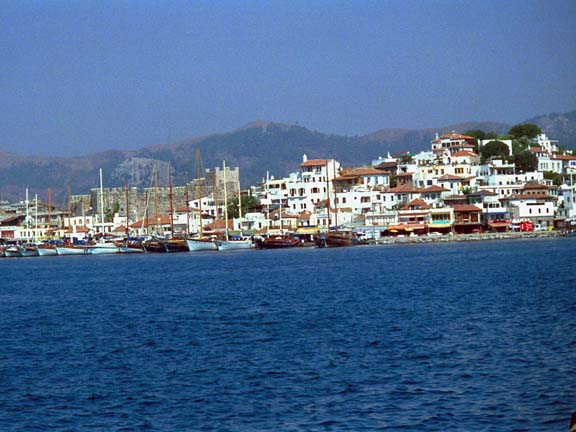Fauna and Flora treasure in the Marmaris National Park and Special Protected Areas.
Marmaris is one of the richest regions of Turkey from the point of plant cover. Including the town centre and the National Park, the whole region of Marmaris is protected. The protected area covers Marmaris National Park, the city centre, İçmeler, Armutalan, Nimara Peninsula, Turunç, Kumlubük, the Fake Strait, Günnücek and Aksaz (up to Köyceğiz-Ekincik boundary). There are also two specially protected areas. These are:
- Gökova
- Datça-Bozburun
Marmaris National Park : The National Park is mainly comprised of red pine (pinus brutia). The sweetgum trees being an endemic type are gathered in certain regions of the area. Red pine, oak, plane tree, cypresses form a beautiful landscape together in the valley. There are also, tree formed plants like wild olive, arbutus, sumac, locust, oleander and laurel spread over a wide area in the National Park.
The wild life is quite rich. Besides the wild goats which live especially between Marmaris-Köyceğiz, there are also mammals like bears, foxes, pigs, red squirrels, weasels, hedgehogs, lynx, martens, jackals etc. The variety of birds living in the region attracts your attention. Besides the eagle and falcon, wide areas also host immigrant birds increasing the variety.
Gökova environmental special protection region: This region plays an important role in yacht tourism with its indented coast. Red pine and sweetgum (liquidambar orientalis) forests hold good value in the region, where it is possible to see all the Mediterranean plants together.
High quality forests concentrate in the Kıran M ountain slopes on the north coast of the Gökova Inlet. Gökova and surrounding mountains accommodate rich flora.
This region is rich also from the point of animals. There are many wild animals living there especially in the southern part of the bay.
The natural plant cover is formed by Mediterranean plant types like olive, red pine, sandalwood and almond. Besides thyme, garden sage, laurel leaves, bambus bees which help in pollination of plants in hothouses and wild goat (capra aegagrus) accumulate in the biological richness of the region.
Bozburun Peninsula environmental special protection region: The region remained untouched due to difficulties in transportation. Regions outside the settlements are defined as cultural and natural protected areas. Datça and Bozburun settlements have been developed as large settlement centers. Datça and surrounding urban protected areas are planned to comply with the architectural styles in the region.
Monumental trees
Registered monumental trees in the region are as follows: Plane and cypress trees in Bayır, plane tree in Söğüt, plane tree in Hisarönü.
Wetlands
All waters, marshes, reed beds no deeper than 6m are defined as wetlands according to the International Ramsar Contract. Wetlands in the region are: The Gökova region coast and stream systems in Akyaka district, Akçapınar and Gökçe Villages, Akbük stream systems in Akbük Bay and Hisarönü stream systems in Hisarönü Bay.
Endemic plants in Marmaris
The list of plant species in a region is called Flora. If the variation of the plants is very special and limited to only one area, such plants are called endemic. The National Park in Marmaris and Gökova, Datça-Bozburun Environmental Special Protected areas all have endemic richness.
Some of the plant species are as follows:
Onopordum caricum: A type of thorn named after the old name of the region.
Globularia dumulosa, cyclamen trochopteranthum, campanula fruticulosa, liquidambar orientalis. Also, garden sage, thorny daisy, cow tail and a type of date (phoenix theoqhrasti) which was supposed to be present only in Crete can also be listed as endemic.
Forest camps
Pamucak forest camp: Pamucak forest camp is located on the Marmaris-İçmeler coast line, 8kms from the city centre covering an area of 42,059 m 2 an area of red pine trees.
Çubucak forest camp: It is on the 22 nd km of the Marmaris-Datça road, Hisarönü Gulf coast, covered with red pine, myrtle, laurel and sweetgum trees. The camp is spread along a 1800m coast line with a capacity to hold of 400 tents, 35 caravans and 1000 visitors per day.
İnbükü forest camp: This camp is situated on the Hisarönü Gulf coast at a distance of 16km from Çubucak. It covers three bays: İnbükü, Çökertme and Cave Bays, accommodating 150 tents and 20 caravans. The forest is consists of sweetgum, laurel, myrtle and red pine trees.
Günnücek forest camp: It is on the way to Fake Strait, 1km away from Marmaris, covering an area of 26 hectares which allows 300 visitors per day. The forest contains sweetgum and laurel trees. Because sweetgum is called “günnük” among the locals, the bay is named Günnücek after the günnük (sweetgum) tree.
Bucak forest camp: This camp is located 5km from the Çamlık Village junction on the 15thkm of the Marmaris-Muğla road in Gökova Gulf.
A kiosk, WC, phone, water and power services are available at the camp site which covers an area of 5 hectares. Boats going to Sedir Island depart from this camp.
Çetibeli forest area: It is located on the 20 th km of the Marmaris-Muğla road. A 5 hectare area is covered in red pine, sweetgum and plane trees. There is an open air cafe in the Muğla architecture and a fountain with fresh drinking water.




No comments:
Post a Comment